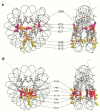Application of mass spectrometry to the identification and quantification of histone post-translational modifications
- PMID: 15211567
- PMCID: PMC2572815
- DOI: 10.1002/jcb.20106
Application of mass spectrometry to the identification and quantification of histone post-translational modifications
Abstract
The core histones are the primary protein component of chromatin, which is responsible for the packaging of eukaryotic DNA. The NH(2)-terminal tail domains of the core histones are the sites of numerous post-translational modifications that have been shown to play an important role in the regulation of chromatin structure. In this study, we discuss the recent application of modern analytical techniques to the study of histone modifications. Through the use of mass spectrometry, a large number of new sites of histone modification have been identified, many of which reside outside of the NH(2)-terminal tail domains. In addition, techniques have been developed that allow mass spectrometry to be effective for the quantitation of histone post-translational modifications. Hence, the use of mass spectrometry promises to dramatically alter our view of histone post-translational modifications.
Copyright 2004 Wiley-Liss, Inc.
Figures


Similar articles
-
Characterization of histones and their post-translational modifications by mass spectrometry.Curr Opin Chem Biol. 2007 Feb;11(1):66-73. doi: 10.1016/j.cbpa.2006.11.022. Epub 2006 Dec 6. Curr Opin Chem Biol. 2007. PMID: 17157550 Review.
-
Identification of novel histone post-translational modifications by peptide mass fingerprinting.Chromosoma. 2003 Aug;112(2):77-86. doi: 10.1007/s00412-003-0244-6. Epub 2003 Jul 9. Chromosoma. 2003. PMID: 12937907
-
Proteomics in chromatin biology and epigenetics: Elucidation of post-translational modifications of histone proteins by mass spectrometry.J Proteomics. 2012 Jun 27;75(12):3419-33. doi: 10.1016/j.jprot.2011.12.029. Epub 2012 Jan 3. J Proteomics. 2012. PMID: 22234360 Review.
-
Tandem affinity purification of histones, coupled to mass spectrometry, identifies associated proteins and new sites of post-translational modification in Saccharomyces cerevisiae.J Proteomics. 2016 Mar 16;136:183-92. doi: 10.1016/j.jprot.2016.01.004. Epub 2016 Jan 9. J Proteomics. 2016. PMID: 26778144
-
A combination of different mass spectroscopic techniques for the analysis of dynamic changes of histone modifications.Proteomics. 2004 May;4(5):1382-96. doi: 10.1002/pmic.200300743. Proteomics. 2004. PMID: 15188406
Cited by
-
Peptide mass mapping of acetylated isoforms of histone H4 from mouse lymphosarcoma cells treated with histone deacetylase (HDACs) inhibitors.J Am Soc Mass Spectrom. 2005 Oct;16(10):1641-53. doi: 10.1016/j.jasms.2005.06.001. J Am Soc Mass Spectrom. 2005. PMID: 16099169 Free PMC article.
-
Chemical and biochemical approaches in the study of histone methylation and demethylation.Med Res Rev. 2012 Jul;32(4):815-67. doi: 10.1002/mrr.20228. Med Res Rev. 2012. PMID: 22777714 Free PMC article. Review.
-
The tale beyond the tail: histone core domain modifications and the regulation of chromatin structure.Nucleic Acids Res. 2006 May 19;34(9):2653-62. doi: 10.1093/nar/gkl338. Print 2006. Nucleic Acids Res. 2006. PMID: 16714444 Free PMC article. Review.
-
Dynamic nucleosomes.Chromosome Res. 2006;14(1):5-16. doi: 10.1007/s10577-005-1026-1. Chromosome Res. 2006. PMID: 16506092 Review.
-
Tissue-specific expression and post-translational modification of histone H3 variants.J Proteome Res. 2008 Oct;7(10):4225-36. doi: 10.1021/pr800044q. Epub 2008 Aug 14. J Proteome Res. 2008. PMID: 18700791 Free PMC article.
References
-
- Berger SL. Histone modifications in transcriptional regulation. Curr Opin Genet Dev. 2002;12:142–148. - PubMed
-
- Cocklin RR, Wang M. Identification of methylation and acetylation sites on mouse histone H3 using matrix-assisted laser desorption/ionization time-of-flight and nanoelectrospray ionization tandem mass spectrometry. J Protein Chem. 2003;22:327–334. - PubMed
-
- DeLange RJ, Fambrough DM, Smith EL, Bonner J. Calf and pea histone IV. I. Amino acid compositions and the identical COOH-terminal 19-residue sequence. J Biol Chem. 1968;243:5906–5913. - PubMed
-
- Edmonds CG, Loo JA, Smith RD, Fuciarelli AF, Thrall BD, Morris JE, Springer DL. Evaluation of histone sequence and modifications by electrospray ionization mass spectrometry and tandem mass spectrometry. J Toxicol Environ Health. 1993;40:159. - PubMed
Publication types
MeSH terms
Substances
Grants and funding
LinkOut - more resources
Full Text Sources
Other Literature Sources

